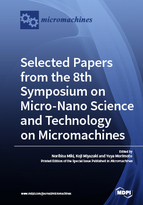Selected Papers from the 8th Symposium on Micro-Nano Science and Technology on Micromachines
A special issue of Micromachines (ISSN 2072-666X).
Deadline for manuscript submissions: closed (28 April 2018) | Viewed by 66764
Special Issue Editors
Interests: micro/nano engineering and science; human interface; interaction/cognitive science/media art; medical engineering; artificial organ; machine learning; artificial intelligence (AI); MEMS (microelectromechanical systems)
Special Issues, Collections and Topics in MDPI journals
Interests: thermophysical properties; thermoelectrics
Special Issue Information
Dear Colleagues,
This Special Issue will publish selected papers from the 8th Symposium on Micro-Nano Science and Technology on Micromachines, 31 October–2 November, 2017, in Hiroshima, Japan.
We encourage contributions on significant and original works in order to deeply understand physical, chemical, and biological phenomena in micro/nano scale and to develop applied technologies. The conference will cover the following main topics:
1: Precision Machinery Lubrication Design
2: Material dynamics Strength
3: Hydrodynamics
4: Thermal engineering
5: Production processing Mechanical materials
6: Robotics Mechatronics
7: Medical Biotechnology
8: Micro Nano system
Papers attracting most interests in the conference, or that provide novel contributions, have been selected for publication in Micromachines. These papers will be peer-reviewed for validation of research results, developments and applications.
Prof. Dr. Norihisa Miki
Prof. Dr. Koji Miyazaki
Guest Editors
Manuscript Submission Information
Manuscripts should be submitted online at www.mdpi.com by registering and logging in to this website. Once you are registered, click here to go to the submission form. Manuscripts can be submitted until the deadline. All submissions that pass pre-check are peer-reviewed. Accepted papers will be published continuously in the journal (as soon as accepted) and will be listed together on the special issue website. Research articles, review articles as well as short communications are invited. For planned papers, a title and short abstract (about 100 words) can be sent to the Editorial Office for announcement on this website.
Submitted manuscripts should not have been published previously, nor be under consideration for publication elsewhere (except conference proceedings papers). All manuscripts are thoroughly refereed through a single-blind peer-review process. A guide for authors and other relevant information for submission of manuscripts is available on the Instructions for Authors page. Micromachines is an international peer-reviewed open access monthly journal published by MDPI.
Please visit the Instructions for Authors page before submitting a manuscript. The Article Processing Charge (APC) for publication in this open access journal is 2600 CHF (Swiss Francs). Submitted papers should be well formatted and use good English. Authors may use MDPI's English editing service prior to publication or during author revisions.
Keywords
-
Micro/Nanofabrication
-
Micro/Nanofluidics
-
Micro/Nano thermal engineering
-
MEMS technology
-
Robotics
-
Lab-on-a-chip
Related Special Issues
- Selected Papers from the 9th Symposium on Micro-Nano Science and Technology on Micromachines in Micromachines (15 articles)
- Selected Papers from the 10th Symposium on Micro-Nano Science and Technology on Micromachines in Micromachines (9 articles)
- Selected Papers from the 11th Symposium on Micro-Nano Science and Technology on Micromachines in Micromachines (5 articles)
- Selected Papers from the 12th Symposium on Micro-Nano Science and Technology on Micromachines in Micromachines (10 articles)
- Selected Papers from the 13th Symposium on Micro-Nano Science and Technology on Micromachines in Micromachines (6 articles)
- Selected Papers from the 14th Symposium on Micro-Nano Science and Technology on Micromachines in Micromachines








